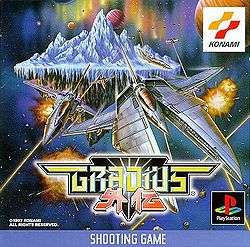Gradius Gaiden
| Gradius Gaiden | |
|---|---|
 Japanese PlayStation box art | |
| Developer(s) | Konami |
| Publisher(s) | Konami |
| Director(s) | Teisaku Seki |
| Producer(s) | Kazumi Kitaue |
| Composer(s) | Norikazu Miura |
| Series | Gradius |
| Platform(s) | PlayStation, PlayStation Portable (as part of Gradius Collection) |
| Release date(s) |
PlayStation
PlayStation Portable |
| Genre(s) | Scrolling shooter |
| Mode(s) | Single-player, multiplayer |
Gradius Gaiden (グラディウス外伝 Gradiusu Gaiden) is a 1997 horizontal scrolling shooter video game developed and published by Konami for the PlayStation console. The game was released exclusively in Japan on August 28, 1997 and was later re-released on November 20, 2003 as part of the PSone Books collection. Gradius Gaiden didn't see availability outside Japan until the release of Gradius Collection on the PlayStation Portable, which was released worldwide in 2006. Gradius Gaiden is the first game in the Gradius series to incorporate 3D graphics.
Gameplay

The core gameplay of Gradius Gaiden remains relatively unchanged. However, two new ships are made available whose weapon configurations are new to the series. Moreover, several changes were made on the weapons system. The chargeable E. Laser, the Reduce size shield, option types, are all items that have been removed in the transition from Gradius III: From Legend to Myth to this title. The player can select from four ships instead of a broad range of several weapon configurations like from Gradius III. Missile, Double, and Laser weapons can be additionally powered up one level, a feature from the MSX Gradius games (the powerup bar even resembles the one from the MSX games). These power-ups are permanent until the player is destroyed, even if he switches between the Double and Laser powerups. There are two new types of shield: 'Guard', which attaches to the top and bottom of the craft and renders the player immune to physical obstacle collisions; and 'Limit', which gives complete invulnerability and lasts for three seconds.
The difficulty level can also be adjusted from 'easiest' up to 'hardest', for a total of nine difficulty levels including the boss rush. On the easier difficulties, the more troublesome boss attacks are removed and the number of enemies on-screen is reduced. At the near end of the eighth stage starting from the second loop of the game play, a Core Warship is added.
A player can rearrange the items in the power meter. This feature is only available in this edition in its series.
There are two new ships:
- Jade Knight: Eponymously, every weapon this ship has is tinted green, including the options. Its missile, the spread bomb, is a carry-over from Gradius II: Gofer's Ambition. This ship has two different kinds of lasers available: round and pulse. The round laser, the most unusual weapon presented in this game, fires concentric rings of laser origination. The pulse laser is a two or three pronged burst laser, similar to the twin laser in previous titles.
- Falchion β: This ship's weapons are variations on well known themes. The Falchion has a two way missile called a rolling missile, which tumbles to the ground where it splits and shoots both left and right. It also has a three-way limited range shot called Auto-Aiming, that fires a second shot within the angles of 0 to 180. Its laser weapon is the gravity bullet, which is a newcomer to the Gradius series but is present in several earlier Parodius titles. It is based on the Spread Gun that is yielded by Pentarou in Parodius Da! and every title afterward. It has been speculated that the ship is not new at all, but an upgrade of the Falsion from the 1987 Konami Famicom Disk System game of the same name.
Plot
The setting is between Gradius III: From Legend to Myth and Gradius IV: Resurrection. During the " Third Bacterian War ", the planet Gradius defeated the Bacterians, and peace returned to Gradius. After two hundred years passed, Gradius prospered, but the nightmare returned after the disappearance of a science vessel which went to a nebula known as "The Evil Range". Shortly after, the colony planets of Gradius were attacked by some unknown force that destroyed 99% of the Gradius Army. The Gradius Army Headquarters decided to launch a desperation attack on the "Dark Nebula", which was the source of the invaders. Four Hyper Space Fighters launched from the mothership with orders to stop them.
Development and release
Gradius Gaiden never initially saw availability outside Japan until the release of the PlayStation Portable compilation, Gradius Collection, in 2006 for North America and PAL regions.
Reception
| Reception | ||||||||||||
|---|---|---|---|---|---|---|---|---|---|---|---|---|
| ||||||||||||
Gradius Gaiden received positive reviews.
References
- ↑ "Gradius Gaiden for PlayStation". GameRankings. 1997-08-28. Retrieved 2016-08-17.
- ↑ "Archived copy". Archived from the original on 2011-07-11. Retrieved 2010-12-14.
External links
- Gradius Gaiden at Gradius Home World
- Gradius Gaiden at Planet Gradius
- Gradius Gaiden at MobyGames